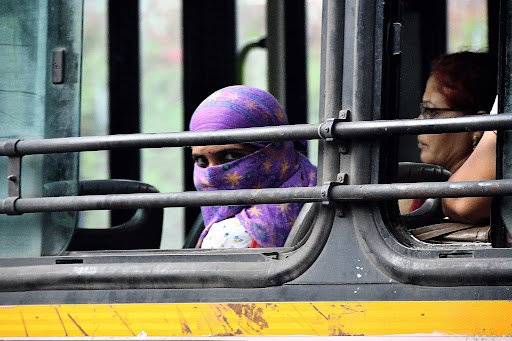Safe mobility: A way to empower women

Gender-aware transport systems, key to women’s economic empowerment
A country’s progress is defined not just by economic growth, but also by the improved living standards and wellbeing of all citizens. Within the ambit of fundamental human rights, the right to free movement is very crucial and can be achieved only through provisioning of safe mobility for all irrespective of their social identity. Simply put, this means that everyone should have the freedom to travel and access public spaces without feeling the threat of any form of violence.
India is rapidly urbanizing and cities come with the promise of economic growth and prosperity. However, due to lack of gender sensitive urban infrastructure planning, men and women have starkly different experience of the city. This is true even in the case of the urban transport sector which does not always cater to the needs to women passengers. Strengthening this argument further, a work in progress at IWWAGE finds that one of the factors adversely affecting female workforce participation is the unavailability of safe and affordable modes of transportation. It is crucial to bridge this gap because absence of reliable transportation options reduces women’s career prospects, reinforces poverty, and further exacerbates inequality.
The three major elements which influence women’s mobility and accessibility are cost, personal security, time poverty, as well as cultural perceptions and spatial location. According to a recent ITF study, women are more likely than men to use public transportation globally because they lack access to private vehicles and moreover they are even more susceptible to assault in public areas. The ‘safety’ and ‘security’ of transportation are the main determinants of women’s mobility behaviors and choices. An ILO study stated that women’s capacity to participate in paid work is positively correlated with transportation-related infrastructure and services. Women have more bargaining power over their mobility within the household when they have access to affordable and safe transportation. Before and during the pandemic, ORF conducted a survey of 4262 women from 140 Indian cities to determine the effect of safety concerns on women’s mobility over a ten-month period. It was found that about half of the women (around 56%) believed that public transportation is unsafe and about the same number has experienced sexual harassment while using a public transportation system. Moreover, 52 percent of women had turned down an opportunity for education or employment because of risky transportation.
Continuing the earlier point, Girija Borker’s study revealed that women have a significantly higher trade-off when choosing a college as compared to male students. Borker found that women are more likely to choose a college that is 25 percentage points lower in the quality distribution, for a route that is deemed to be safer as compared to men, who are willing to attend a college that is 5 percentage points lower in the quality distribution for a similar safer route. Choosing lower rung colleges adversely affects employment prospects and placement salaries, which further perpetuate the gender disparity in the job market. In addition, women have to bear ‘pink tax,’ a term used to elucidate the extra amount paid by women for safety and they typically spend INR 18,800 more per year on commuting compared to their male counterparts for a route that is safer, which aggravates the economic hardship and decline in female labor force participation.
On a global level, several steps have been taken to provide safe mobility for women. For instance, in 2015 in the pursuit to make public transport safe for females in Papua New Guinea, a ‘Meri Seif Bus’ has been offered as part of the ‘Safe Public Transport for Women and Children Programme’ with tracking systems and three uniformed bus crews for a safe mobility. Similarly, other countries like Tokyo in Japan, Malaysia, Rio de Janeiro in Brazil and Jakarta in Indonesia among others have started women dedicated coaches in bus or trains for ensuring safety and prevention of sexual harassment against women.
In the Indian context, the Delhi government in 2019 made DTC bus rides free for women passengers in order to combat the safety issues. It aimed to encourage females to use public transport. In terms of equality, affordability, and convenience, providing women free bus trips in Delhi is a significant advancement. Free bus fares for women make transit more accessible to Delhi’s female population, reducing their financial burden. This provision contributes to closing the gender gap in transportation access, making it easier for women to reach their destinations with more ease and safety. The state economic survey reports that the number of female passengers availing free rides has climbed from 193.2 million to 217.1 million from 2019-20 to 2020-21. In 2021-22, more than 30 million women have availed free bus rides despite COVID restrictions. If we carefully evaluate the scheme, we can see that it ticks the pricing and accessibility boxes but might be neglecting the safety issue, which still remains a major concern. It is undeniable that it provides women with greater protection than walking or taking autorickshaws. However, there is a need to strengthen this effort by taking measures for improved safety so as to meet its initial goal of providing secure and affordable transportation to women in Delhi.
Given that women’s growth and development – both in terms of social and economic aspects – is so closely related to transportation, there is a compelling case for designing woman-friendly transportation systems and employing more women in the transport sector. This would help create an atmosphere that makes them feel safe and secure throughout their entire journey. A few examples include providing appropriate street lighting along the route to the following stations, lively waiting areas where they feel at ease, and dependable drivers and public transportation staff. There should be women police personnel in all major transportation hubs, including bus stops, train stations, and congested walkways, along with live traffic monitoring by a dedicated task force at the closest traffic station to record actions and take immediate necessary steps. There should be appropriate channels for women to report harassment or other problems they encounter when using public transportation, such as a hotline number and this service needs to be regularly monitored to identify lapses corrective measures that need to be taken. Additionally, nighttime patrols can help improve women’s perceived safety.
The Indian government has put in place other measures such as the ‘Women and Child Helpline’ and the establishment of ‘Women Special’ buses and trains in Tamil Nadu and Maharashtra to ensure the safety of female passengers. But, this alone is not sufficient. Adopting a more holistic approach, it is essential to include women at all stages of public transport system development, including planning and decision-making as well as leadership roles in civil society and government organizations. This is crucial to better understand and address the day-to-day issues and lived experience of women. Equitable transportation is critical for everyone because it promotes inclusiveness and respect for human rights while also fostering sustainable urban development. Merely providing cheap/free rides will not fully serve the purpose unless it is backed by robust measures to meet safety and other gender-specific requirements.
Suchika Gupta is a Research Associate at IWWAGE with an interest in developmental issues and seeks to work in areas of evidence-based solutions for policy formulation.
- Posted In:
- Latest Blogs






















































Leave a Reply